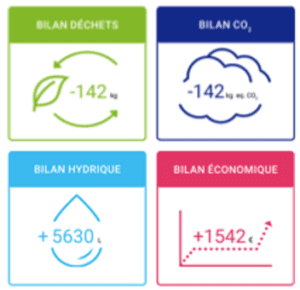The Circular Signature® allows to simulate product combinations and to deliver to the owner a controlled circular performance, which tends towards carbon neutrality (expected for 2050 at the European level)… provided that future used resources are properly managed in a regenerative ecosystem, to do what we call Resource Management. Indeed, it would be hard to imagine that the carbon that is sequestered in wood-frame buildings and biobased products would be released during the next deconstruction, because the wood would be incinerated or buried. However, this is what happens all too often.

This article is a follow-up to “The Ecodesign of a “Materials Bank Building” in 3 Points”
The role of the Resource Manager in a circular building

In the absence of resource management over time that would result in end-of-life recovery such as reuse, upcycling or recycling, any eco-design would be useless. This is why this management, which is still called Resource Management, is an essential complement to eco-design.
The owner’s Resource Manager®(or delegated Property/Facility Manager) leverages the functions of the Digital Materials Bank to identify and track profitable value-added ecosystems, through reuse, upcycling or recycling, and ensure that a building is a source of revenue and not waste. Initial experience suggests a ROI of up to 15% of the product acquisition cost (source: Upcyclea), bearing in mind that the scarcity of resources and certain pandemic or geopolitical events may inevitably increase the value of products “placed” in the buildings. That’s why we talk about “digital banking” and “material banking”.
Ecosystem valuation indicators
Here again, digitization and data reported by stakeholders can be used to generate ecosystem indicators that measure the volume of waste andCO2 avoided, the water balance and the economic balance of each ecosystem.
To be resilient and meet the 2050 “Net-0 Emissions” objectives, the city must control the resources it uses and industrialize its deconstruction, construction and building management processes to regenerate these resources. Digitization of information and processes is a prerequisite for managing the complexity of the circular model, and enabling the implementation of low-carbon ecosystems… and profitable ones. Because without profitability, there is no circular economy, and without a circular economy there is no resilience or carbon neutrality.
More than a lever, digital technology has become a necessity to move into a post-industrial era that harmoniously combines ecology and economy.
